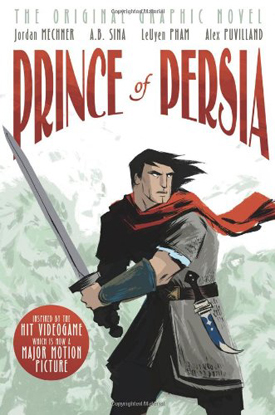 Prince of Persia presents us with another of the increasing number of spin-offs from gaming. It’s an intriguing story, sometimes filled with pathos, sometimes hair-raising, and always ambiguous. (And in case you were wondering, the plot of the graphic novel is not related to any of the storylines of the game or that of the film. Well, pretty much.)
Prince of Persia presents us with another of the increasing number of spin-offs from gaming. It’s an intriguing story, sometimes filled with pathos, sometimes hair-raising, and always ambiguous. (And in case you were wondering, the plot of the graphic novel is not related to any of the storylines of the game or that of the film. Well, pretty much.)
We begin in the city of Marv in the 9th century. The king of Marv has been overthrown by one of the Caliph’s generals, who places himself on the throne. He also adopts the son of the former king’s general, whom he killed in battle, and raises him with his own two children, Guiv and Guilin. When the time comes, however, he names his adopted son, Layth, as his successor. Layth marries Guilin. When the story opens, Layth is having Guiv put to death by drowning. Guilin threatens to kill herself.
The story then cuts to the 13th century. Shirin, daughter of a wealthy minister, is having a dance lesson from Arsalan, who tells her it is the last lesson, on her father’s orders. It seems, however, that Arsalan is something other than a mere dance master, and under Shirin’s repeated and insistent questioning, he tells her to go to the tree by the well outside the city. Disguising herself as a beggar boy, she goes to the well. On the way, she witnesses some of the injustice being perpetrated by the city’s guards. Ultimately, she falls into the well and is rescued by a young man who lives in the ruined citadel atop a nearby mountain and knows intimately the system of conduits that provide water to the farmers — or used to, before the oligarchs. Ferdos has been hidden for his entire life, being cared for by the Guardian of the Waters (an official title in the city). He may also be Guiv, who left the city four hundred years before, an exile by his own choice, accompanied only by a peacock.
The story is, as I said, built on ambiguity, mostly involved with time, which is something that does play a key role in several of the game scenarios. Characters and events flow together, personalities merge, and the reader is never quite sure exactly whose story is being told. If you can deal with that, it is absorbing and well-executed. I suppose I should say “the stories,” because there are really two: the story of Layth, Guilin, and the increasing corruption in the city as the ministers take over the government of a king who doesn’t want to govern, and the story of Ferdos and Shirin, living hidden from a city that no longer bothers with a king, but is still corrupt.
One is tempted to read topical commentary into this narrative, but it’s more realistic, I think, to take any such message in larger terms: the fall of Marv is the story of any nation in which self-interest is the ruler. There is, however, a strong element of — I hesitate to say “fatalism,” although that comes close — perhaps inevitability to events, and a sense of a wider perspective, brought home through the peacock, who is guide, mentor, and sometimes adversary.
The graphic work, by LeUyen Pham and Alex Puvilland, is a little hard to describe. While layouts are quite standard, frame-follows-frame affairs, there are passages in which the images carry the narrative completely, while there are also passages in which narration and dialogue are intertwined with images in seamless and very effective synthesis. The style itself is refreshing, marked by strong, definite drawing and bright, flat color — but, interestingly enough, there is little hint of the tradition of the Persian miniature, in spite of the context of the story (except one passage in which Ferdos is relating to Shriin the history of Layth, Guiv, and Guilin from a set of scrolls he painted himself). Character designs are appealing, but this is not a Western ideal of beauty, particularly.
If you can deal with stories set four hundred years apart that seem to blur into each other, abrupt transitions between stories that may not be transitions, all set in a lively and somewhat exotic graphic style, take a look at Prince of Persian. In fact, take a look at it anyway.
(First Second, 2008)
